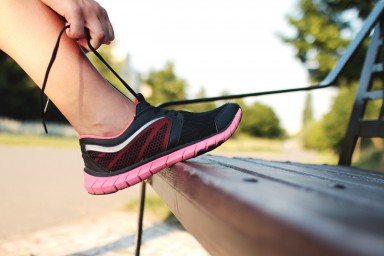 For those over the age of 40 starting to feel the painful effects of foot dysfunction, it may not come as a surprise that more than 80% of people will have foot problems in their lifetime. Meanwhile, those under 40 tend to rarely think about their feet, primarily because they don’t hurt yet. Many do not realize that foot dysfunction can cause pain in other areas of the body such as the knees, hips and lower back. Interestingly, many of the foot problems we suffer from such as metatarsalgia, plantar fasciitis and bunions are largely confined to westernized individuals. This suggests that foot dysfunction is the result of a cultural factor: restrictive footwear, not necessarily aging.
For those over the age of 40 starting to feel the painful effects of foot dysfunction, it may not come as a surprise that more than 80% of people will have foot problems in their lifetime. Meanwhile, those under 40 tend to rarely think about their feet, primarily because they don’t hurt yet. Many do not realize that foot dysfunction can cause pain in other areas of the body such as the knees, hips and lower back. Interestingly, many of the foot problems we suffer from such as metatarsalgia, plantar fasciitis and bunions are largely confined to westernized individuals. This suggests that foot dysfunction is the result of a cultural factor: restrictive footwear, not necessarily aging.
Anthropological studies have shown that humans have worn protection on their feet for thousands of years to allow them to cover greater distances more rapidly. Of course, those early shoes were much simpler in design than most of our shoes today. The modern athletic shoe, or ‘Pronation-Control, Elevated Cushion Heel’ (PCECH) shoes have features which are intended to reduce the risk of injury. However, several studies have shown that even when these PCECH shoes are assigned by foot shape, as often done by running stores and medical practitioners, the frequency of injury is increased. (1,2)
One explanation for this is that the features built into these shoes just aren’t doing what we thought they would. Thick cushioning is supposed to reduce injury by decreasing impact forces. Differences in surface hardness (i.e. more/less cushioning) however, do not significantly change these impact forces. Rather, the stiffness of muscles change in order to accommodate these differences. (3,4) While cushioning feels nice, it also prevents us from using the over 1,300 nerve endings per square inch found on the bottoms of our feet, which provide positional awareness (proprioception) for the foot and the rest of the body. (5) This poor proprioception has even been shown to delay activity of the stabilizing musculature of the spine. (6)
An elevated heel is thought to reduce achilles tendon strain. However, the incidence of achilles injuries has increased since the introduction of PCECH shoes in the 1970’s. (7) The elevated heel causes an increase in hip adduction (inward motion), and an increased incidence of osteoarthritis of the knee. (8,9) Another common misconception is that the amount of pronation (the inward roll of the foot during normal motion) affects injury rate, although foot type (i.e under/over pronator) has not been consistently associated with injury. (10,11,12) Additionally, arch support and orthotics have been shown to be ineffective in altering the amount of pronation. (13) Athletic shoes are potent examples of failed attempts to optimize foot function. The issue is not limited to athletic shoes, but is also with casual footwear. It seems that research continues to provide evidence that the best shoe for reducing injury and optimizing function, is a shoe that is barely a shoe at all.
Conventional shoes not only affect the bone structure of the foot, but the musculature of the foot, too. The elevated heel and toes of many shoes stretch muscles beyond lengths where they can contract effectively, thus leading to atrophy. Good news, though – evidence supports that transitioning to minimalist footwear can strengthen muscles in the midfoot, thus improving overall function of the foot.(16,17) Some of the foot dysfunction that we have accumulated over the years is reversible! Minimalist footwear attempts to mimic being barefoot, which means they should be flat (no heel), flexible, with a thin sole, and widest at the toes. How minimal is right for you, will depend on where you’re starting from.
As a physical therapist interested in the bigger picture, I cannot ignore the implications of foot dysfunction on the rest of the body. I frequently prescribe minimal footwear, not only for lower leg injuries, but even for problems with the knees, hips or low back. Even in small doses, I think that “going minimal” has immediate benefits to overall health. Whether your ancestors were gathering vegetation all day or hunting prey for miles on end, I doubt they were complaining of foot problems. Just because we no longer use our feet in these capacities, that doesn’t mean we should forget about them! And if you decide you’re a hunter, I suggest you start training your bare feet today!
So what’s the takeaway? Change your footwear. Do your best to avoid doing “too much, too soon.” Your feet are likely weak from a lifetime of faulty footwear. Begin by wearing more minimalist shoes for a few everyday activities, such as walking your dog or running errands.
If you’re looking for more advice on how to make the transition to minimalist footwear, you can schedule with Chris at Latitude Physiotherapy!
 Dr. Chris Gumbs, PT, graduated from the University of St. Augustine in Austin, TX, in 2014 giving him a strong foundation in manual therapy and orthopedics. He has spent his time since graduation sharpening his skills as a manual therapist, improving his treatment of myofascia, and learning how to best reintroduce functional movement. Chris has been a competitive runner since middle school, and he is passionate about providing runners with the best information in regards to the prevention of running injuries. His other professional interests include ‘barefoot’ or minimalist footwear, kinematic chain dysfunction, the influence of sub-optimal breathing patterns on posture, and dry needling.
Dr. Chris Gumbs, PT, graduated from the University of St. Augustine in Austin, TX, in 2014 giving him a strong foundation in manual therapy and orthopedics. He has spent his time since graduation sharpening his skills as a manual therapist, improving his treatment of myofascia, and learning how to best reintroduce functional movement. Chris has been a competitive runner since middle school, and he is passionate about providing runners with the best information in regards to the prevention of running injuries. His other professional interests include ‘barefoot’ or minimalist footwear, kinematic chain dysfunction, the influence of sub-optimal breathing patterns on posture, and dry needling.
Web Resources:
- https://www.correcttoes.com/foot-help/articles-studies/#contentArea
- https://www.vivobarefoot.com/us/science
- American College of Sports Medicine’s Recommendations on Running shoes: https://www.acsm.org/docs/brochures/running-shoes.pdf
- A Quick Guide to Transitioning to Running Sandals – a great guide that can be modified for transitioning to more minimal footwear for either walking or running: https://cdn.shopify.com/s/files/1/1042/9326/files/Mike-Prevost-Quick-Guide-to-Transitioning-to-Running-Sandals.pdf?16935136899152639500&mc_cid=edf2ba8e84&mc_eid=e44041fbcc
References:
- Knapik JJ1, Trone DW, Swedler DI, Villasenor A, Bullock SH, Schmied E, Bockelman T, Han P, Jones BH. Injury reduction effectiveness of assigning running shoes based on plantar shape in Marine Corps basic training. Am J Sports Med. 2010 Sep;38(9):1759-67. doi: 10.1177/0363546510369548. Epub 2010 Jun 24.
- Ryan MB, Valiant GA, McDonald K, Taunton JE. The effect of three different levels of footwear stability on pain outcomes in women runners: a randomised control trial. Br J Sports Med. 2011 Jul;45(9):715-21. doi: 10.1136/bjsm.2009.069849. Epub 2010 Jun 27.
- Feehery FJ. The biomechanics of running on different surfaces. Clin Podiatr Med Surg 1986;3:649–59.
- Nigg B, Wakeling J. Impact forces and muscle tuning: a new paradigm. Exerc Sport Sci Rev 2001;29:37–41.
- Robbins S, Waked E. Foot position awareness: the effect of footwear on instability, excessive impact, and ankle spraining. Crit Rev Phys Rehabil Med 1997;9:53–74.
- Ogon M1, Aleksiev AR, Spratt KF, Pope MH, Saltzman CL. Footwear affects the behavior of low back muscles when jogging. Int J Sports Med. 2001 Aug;22(6):414-9.
- Reinschmidt C, Nigg BM. Influence of heel height on ankle joint moments in running. Med Sci Sports Exerc 1995;27:410–16.
- Sekizawa K, Sandrey MA, Ingersoll CD, et al. Effects of shoe sole thickness on joint position sense. Gait Posture 2001;13:221–8.
- Kerrigan DC, Johansson JL, Bryant MG, Boxer JA, Della Croce U, Riley PO. Moderate-heeled shoes and knee joint torques relevant to the development and progression of knee osteoarthritis. Arch Phys Med Rehabil. 2005 May;86(5):871-5.
- Hreljac A. Impact and overuse injuries in runners. Med Sci Sports Exerc 2004;36:845–9.
- Wen DY, Puffer JC, Schmalzried TP. Lower extremity alignment and risk of overuse injuries in runners. Med Sci Sports Exerc 1997;29:1291–8.
- Taunton JE, Ryan MB, Clement DB, et al. A prospective study of running injuries: The Vancouver Sun Run ‘‘In Training’’ clinics. Br J Sports Med 2003;37:239–44.
- Nigg B. The role of impact forces and foot pronation: a new paradigm. Clin J Sport Med 2001;11:2–9.
- Bolgla LA, Malone TR. Plantar Fasciitis and the Windlass Mechanism: A Biomechanical Link to Clinical Practice. Journal of Athletic Training. 2004;39(1):77-82.
- Sims AL, Kurup HV. Painful sesamoid of the great toe. World Journal of Orthopedics. 2014;5(2):146-150. doi:10.5312/wjo.v5.i2.146.
- Shroyer JF, Etheredge CE, Weimar WH. Effect of minimalist footwear on medial arch height. Med Sci Sports Exerc. 2011; 43:313.
- Brugemann GP, Potthast W, Braunstein B, Niehoff A. Effect of increased mechanical stimuli on foot muscles functional capacity. In: Proceedings of the American Society of Biomechanics, Cleveland (OH). 2005.
